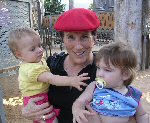
The Human Spirit: Voices
February 6, 2015
A third to half of the children in youth villages are second-and third-generation Israelis from disadvantaged homes.
The teens at Israeli youth villages who are brave and good-natured enough to perform before audiences of supporters from abroad can do no wrong in my eyes.
Sixty years after Israel’s youth villages first served as sanctuaries for homeless children, who arrived with the traumas of the Holocaust, Israeli youth villages are still providing asylum, schooling and life skills to needy Jewish youth: teenagers from the former Soviet Union, Ethiopia, Cuba, the former Yugoslavia and Israel itself. A third to half of the children in youth villages are second-and third-generation Israelis from disadvantaged homes.
There may be swimming pools on gorgeous lawns, but there is nothing country club-like about the villages.
The teens live in no-frills dormitories and do chores, be they milking cows or peeling potatoes. At the heart of each village is a high school catering to the teens’ special needs.
Scattered around Israel are 70 such rural boarding schools inhabited by some 12,500 teenagers; many of these schools are recipients of aid for special programs from donors in Israel and abroad.
They receive visitors with warmth, tackling songs in Hebrew and English, no matter how few months they’ve spent in this country. Sometimes they are off-tune and the lyrics are distorted, but no one cares. The old-fashioned tradition of including music as part of a warm welcome and to honor a dedication is cherished.
But I don’t expect much.
So it was last week, at a ceremony at the Meir Shfeya Youth Village near Zichron Ya’acov for several Hadassah dedications.
Meir Shfeya is named for Amshel Mayer Rothschild, founder of that revered dynasty. The first school was started there back in 1904, providing education for the orphans of the Kishinev pogroms in Bessarabia (today Moldova).
In 1923, Jerusalem orphans from the Diskin Orphanage on Hanevi’im Street were moved there.
The red-roofed village was used as a training base by the Hagana because of its then-remote location in a hilly area.
There’s a computer program but the students still work in agriculture, what the former director used to call “para-psychology” for the Hebrew word for cow – para. The village boasts a prize-winning dairy and a winery that uses its own grapes.
Today, they’re mostly from the former Soviet Union and of Ethiopian background. The student body includes foreign workers too young to work legally, and teens from the nearby upscale towns who value the excellent schooling.
Several of the newer students are from Ukraine; there’s a new immigrant from Donetsk, the strategic port city in eastern Ukraine, where the airport was recently destroyed.“We’re never going back,” she says.
Lauren Kedem, the American-born English teacher who is today’s MC for a ceremony that will include several facility dedications, announces the first singer; he’s a participant in Na’ale.
Na’ale is a program run by the Jewish Agency that offers free high-school education, including room and board, to Jewish teens from 10th grade on. Although high-school students reputedly come from 32 countries, most of those who take advantage of this program are from the former Soviet Union.
Indeed, the singer is a serious-looking teen named Sasha; he grew up in Yekaterinburg in the Ural Mountains.
Yekaterinburg was called Sverdlovsk until 1991, and like Meir Shfeya was also named for a Jewish founder: Yakov Sverdlov, a founder of the Communist Party.
As Sasha begins to sing, eyes open wide. Mouths drop. The operatic tenor fills the hall. I feel as if I’m in the audience when Scottish singer Susan Boyle appeared as a contestant on Britain’s Got Talent in 2009. Middle-aged, matronly dressed Boyle in sensible shoes stunned the skeptical judges and jeering audience with her astounding rendition of “I Dreamed a Dream” from Les Misérables.
Four months after moving to Israel, Sasha is singing Yehoram Gaon’s Yesh Makom (There’s a Place) from the play and movie Kazablan, in flawless Hebrew.
Ironically, it’s an ode of nostalgic longing for Jewish life in Morocco. The boy from Russia’s fourth-largest city – where the average temperature in February is minus 13º, named for a founder of Communism – is singing of a place across the sea where the sun is shining, women are baking hallot and prayer is coming out of every window.
There’s a place far away, beyond the sea
Where the sand is white, the house is welcoming
Where the sun shines
On the outdoor market, the street and the harbor
The house is warm, beyond the sea
I remember the burning candle on
Shabbat night
While he’s singing soulfully, I glance over at gray-haired pianist Boris Feldman; he’s been teaching music at this village since he made aliya in 1990. Back in Minsk, he headed a music academy with 400 students and a waiting list to get in.
“In Minsk, we selected each talented student with tweezers – only the best could get in. I like this job better,” says Feldman. “Here, we accept anyone who wants to study. Occasionally the music changes the lives of troubled children for the better.”
At Meir Shfeya, Feldman runs the Bonnie Lipton Center for the Performing Arts. Among his responsibilities is running a rather famous mandolin orchestra, started in 1923; it was started by Moshe Medalia, also from Russia.
Sasha, it turns out, gave up a scholarship to study opera in Moscow to come to Israel. So Sasha is singing, and Boris is accompanying him on stage – and I’m misting up, experiencing one of those hyper-Israeli moments, realizing that this is the ingathering of the Jewish people and that the best is still to come.
